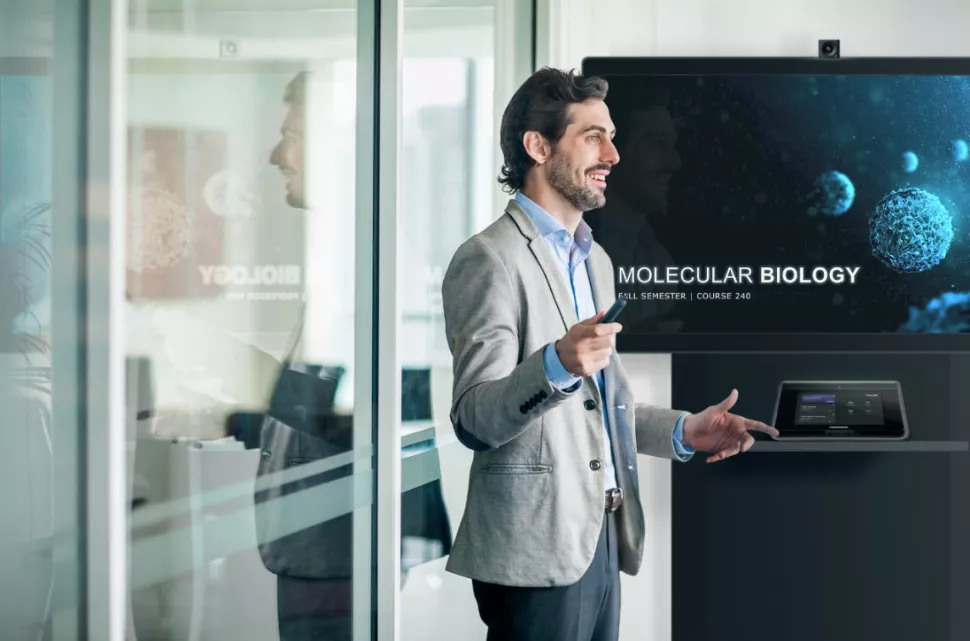How It’s Done: Building a Remote Learning Campus
Dumb luck and smart tech has helped USC create a ‘new normal’ remote learning success story

When Joe Way, Director of Learning Environments-Information Technology Services, was brought on for a major tech reorganization at University of Southern California last August, no one suspected how important the upgrades would come to be for remote learning.
“I’m a USC alum, so this was coming home for me,” says Way. “The first stage of my job was to evaluate the technology we had, the effectiveness of the teaching situation and come up with a plan. So ironically, months before the shutdown, I had already come up with a way to upgrade all of our spaces, across the enterprise, to make them hybrid teaching spaces— bringing in lecture capture, streaming, wireless, all of these things which were nearly nonexistent prior.”
Way went to work, overhauling a campus filled with 10- to 15-year-old legacy tech into one that could support a theoretical shift in future teaching capabilities. Then, COVID-19 entered the scene.
“I had an already approved plan and we were going full steam,” says Way. “Suddenly everyone was asking me, ‘How are we going to do this hybrid learning? ‘How are we going to do this remote teaching?’ So I now look like the smartest person in the room out of complete dumb luck.”
The majority of the project—creating 248 hybrid learning spaces with ceiling-mounted cameras and mics—had been completed. “I was able to do proper research, development, planning, budgeting all before the pandemic hit which made the transition a lot easier,” says Way. “A lot of schools didn’t have that advantage.”
Welcome to the "New Normal"

“We moved five years ahead in adoption of technology in five days because we had no other option,” says Way. “All of those, ‘I hate your tech, I want my chalkboard’— this kind of pushback is gone. The things we've been preaching they have to do are now a given.”
Way is offering online webinars—a very intensive hyper-care program to prepare the faculty for the upcoming changes. The sessions cover everything from instructional design to how to use Zoom to how to teach when no one is in the room.
Tools and ideas to transform education. Sign up below.
“We are really trying to keep the operational side as simple as possible so that the faculty can focus on teaching well, and the questions they are asking are awesome,” says Way. “Usually there's apprehension and reluctance—‘I don't trust this yet.’ It’s understandable, they might have spent ten years developing the way they teach down to a science and we come in with something completely new. But now I see an openness—as long as we can show them ‘This is how you're going to be effective in our new normal,’ there's 100% buy-in. It says a lot about our faculty. Hopefully that relationship and bond we are building will help when the fall comes.”
- The Future of Hybrid Learning
- How to Take College Orientation Online
- College Counseling Is Finding Success Online
Looking into the crystal ball
USC originally anticipated bringing students back to campus, but that was changed amid a spike in COVID-19 cases. Students are being encouraged to opt for online versions of the classes rather than in-person to accommodate social distancing guidelines. Only 10% to 20% of classes are now expected to be on campus.
To support this, a further additional 100 hybrid learning spaces have been added to accommodate a new normal. Should students be asked to completely vacate at any point, educators will have ready-to-film classrooms already in place with established mics and cameras.
All general ed classes that can be streamed are expected to be online, and for the most part, the only in-person classes will be labs, arts, and certain specialty classes.
Obviously health and safety comes first, says Way. “USC is very much about our social network, very much about our USC family—it's what we define ourselves by, it's part of our identity,” he says. “It was important to find a way to offer that, to feel the community. Health standards define how far we can go with that and tech is helping us bridge the gap.”
Passing the test
Before students were sent home, leaders saw a potential remote learning-from-dorms future. While they were still on campus, a week's worth of on-site remote learning was tested, with students attending classes online. “I'd call it a proof of concept,” says Way. “You're all here, you're all joining 50,000 Zoom lessons simultaneously on our campus network—what will happen? It went flawlessly.”
Having jumped that hurdle, institution leaders delved deeper into the data.
“Our network infrastructure team gave their report,” says Way. “Even with the 30-50,000 simultaneous Zoom calls, it still only ranked third in our network traffic behind Youtube and Netflix. We were shocked, really. Everyone on campus just attended online class for an entire week and it still only ranked third in our traffic.”
Now when USC does bring back students, leaders know that remote learning from on campus is a viable option.
A smart central brain . . . and eyes, ears, and mouth

“As part of our redesign when I came on, I did a number of proof of concepts of all the different NAV over IP solutions and ways we could do wireless. It was the Crestron Zoom UC Engine, the Flex UC-Engine, that ended up winning the proof of concept along with their NVX,” says Way.
The hardware made it extremely easy to scale and move to the Zoom and hybrid environment, and was a lifesaver. “We put it at the core of every classroom—it’s really the central brain of every room,” he says. “It allows us to connect and stream and send content anywhere and everyone can use it. We essentially created 350 Zoom rooms, but used the Crestron hardware to do so. That along with their occupancy sensors for a touchless experience, the fact that they are the first to allow HTML 5 for touch panels, gives us the opportunity to have web-based control and cloud control.”
USC is also using their fusion cloud, the XiO Cloud. “I'm very pro moving to software, moving to cloud,” says Way. “I'd say the direction we're going is NAV generally. While others had pieces of the puzzle, Crestron was really the only manufacturer that had an entire ecosystem going that direction and could really pull it all together. A lot of it is still in beta and is still very young and new, but in a way that became our advantage. Being a big enterprise, they've given us our own engineers to work with— it's been a great partnership.”
USC is also the first to use Shure’s MXA710 ceiling microphone. “It’s another silver lining,” Way says of the partnership with Shure. “It can be really expensive to do a cam/mic room, but now with the need and the volume, manufacturers are coming out with better price points.”
Pro tips
Try not to stress because it's going to happen. “You're going to make it through this,” says Way. “We're all going to make it through it.”
Really work with your team. It’s not as big of a project when you realize there are other departments on campus in the same boat who can be there to help. “For us, it’s our Center of Teaching & Learning,” says Way, “Work with your IT team (adding Zoom and the extra network infrastructure needed), work with your facilities team (pulling extra cables for cameras and mics), try not to do this on an island.” Everyone is going through this too, so reach out to those who you might not normally work with.
“As AV people we're always arguing we want a seat at the table, and now we have a seat at the table because we are so important to the business continuity planning at the university,” says Way. “Let's use this as an opportunity to build relationships for the long run. You'll be amazed at when those partnerships grow, exactly how much you can get done.”
Sascha has nearly two decades of experience as a freelance journalist writing for national magazines, including The Washington Post, LA Times, Christian Science Monitor, National Geographic Traveler, and others. She writes about education, travel and culinary topics.

